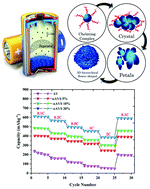Synergic and coupling effect between SnO2 nanoparticles and hierarchical AlV3O9 microspheres toward emerging electrode materials for lithium-ion battery devices
Abstract
The rational design of proficient and durable active materials is an important task for rechargeable Li-ion batteries. Herein, AlV3O9/SnO2 binary nanocomposites (AVS) were fabricated by a low-temperature and short-time PEG-assisted hydrothermal method combined with subsequent calcination. The as-prepapred 3D hierarchical flower-shaped AVS micro/nanosphere composites showed a more specific capacity than those of pristine AlV3O9 (AV) structures due to the coupling effect of two different energy-storage materials. Therefore, SnO2 with a preferable conductivity was equipped with facile electron transport among AlV3O9 and electrode layers. Notably, we followed the changes of the SnO2 content (5, 10, 20 wt%) to investigate the cycle stability, rate capability, and Couloumbic efficiency during the battery testing. As a positive electrode for a Li-ion battery, the cell with AVS nanocomposites including 20 wt% SnO2 was able to deliver a high specific capacity of 611.02 mA h g−1 at a current rate of 0.1C, which represented an upgrade over pristine AlV3O9 (233.05 mA h g−1). The assembled battery with AVS flower-shaped nanocomposites could be steadily cycled for 75 times at a current rate of 1C with an efficiency as high as ∼99%. Therefore, AlV3O9/SnO2 nanocomposites offer considerable promise to realize an operationally attractive Li-ion battery electrode.



 Please wait while we load your content...
Please wait while we load your content...